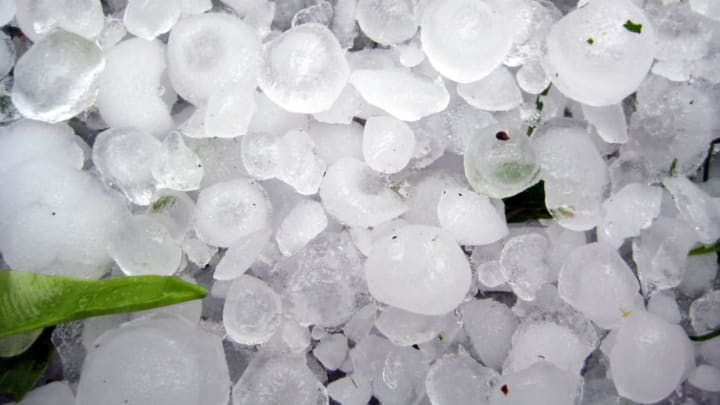The rapid sound of tapping on your windows during a thunderstorm is unmistakable—a not-so-subtle reminder from nature that it can mess up your day in a hurry. No, it’s not a flock of birds out for revenge (not this time, anyway), but rather a ferocious hailstorm raining down on your town. Here are nine hard-hitting facts about these potentially dangerous flying ice balls.
1. DANGEROUS HAIL EVENTS OUTPACE TORNADOES 5 TO 1.
Even though we like to focus on tornadoes during the spring, hail is a much greater (but underappreciated) threat. The number of tornadoes that touch down every year is just a fraction of the number of dangerous hail events we see all across the United States and the rest of the world. The U.S. averages more than 5000 reports of large hail each year, compared to about 1000 reports of tornadoes each year.
2. HAIL FORMS IN A THUNDERSTORM.
It starts its life as a tiny droplet of supercooled water, or water that is still liquid at below-freezing temperatures. Instead of condensing into a raindrop and falling to the ground, the droplet can freeze onto a condensation nucleus like dust or dirt that’s lofted into the storm.
3. INSIDE A STORM, HAILSTONES MOVE LIKE LOTTERY BALLS IN A TUMBLER.

A newly formed hailstone is too light to fall to the ground, so it remains suspended in the thunderstorm by its updraft, which is the fast upward wind that feeds a storm the unstable air it needs to survive. Hailstones move through the thunderstorm sort of like lottery balls mixing in a tumbler, bouncing around in the wind and collecting water on their surface. The hailstone grows as it collects water on its surface and freezes, a process that forms ice in layers like an onion.
4. WHEN IT BECOMES TOO HEAVY, IT FALLS.
Hail plummets to Earth when it’s too heavy for the updraft to keep it suspended in the air. This is why the most intense thunderstorms on Earth, known as supercells, can produce hailstones the size of softballs or larger. After all, It takes a strong wind to keep a heavy ball of ice hanging in the air.
5. MOST HAIL IS TINY.
While we always hear about gigantic hail pummeling places like Oklahoma and Kansas, most of the hail that falls around the world is small. The National Weather Service considers hail “severe” when it reaches 1 inch in diameter, the point at which it’s large enough to begin causing damage to people and property. Even tiny increases in the size of a hailstone beyond that mark make these chunks of ice exponentially more dangerous, as larger hail can reach speeds of close to 100 mph.
6. WHEN IT'S AS LARGE AS A GOLF BALL, TAKE COVER.
The easiest way to convey the size of hail is to compare it to everyday objects. Hail that’s 1 inch in diameter is the size of an American quarter. Hail that’s 1.5 inches in diameter is the size of a ping pong ball. We call hail golf ball size when it reaches 1.75 inches in diameter—and this is when it gets extremely dangerous. Baseball-size hail is 2.75 inches in diameter, large enough to leave a divot in the ground and sound like fireworks when it slams down. When it reaches the size of a grapefruit (4 inches) or softball (4.5 inches), you should probably head underground until the storm moves on. Luckily, these monsters are rare: Hail the size of a grapefruit or larger accounted for just 0.5 percent of all the hail reported during the past 60 years.
Back in July 2010, a small town in South Dakota saw the largest hailstone ever recorded. It fell in the town of Vivian, measuring a whopping 8 inches in diameter and weighing in at nearly 2 pounds. For some perspective, that's nearly the size of a volleyball. The supercell that produced that behemoth also spawned a small tornado and caused wind gusts of up to 80 mph.
7. VEHICLE DAMAGE IS THE BIGGEST DANGER …

Rondo Estrello, Flickr // CC BY-SA 2.0
It goes without saying that ice falling from the sky at highway speeds can hurt if it hits you. Deaths and serious injuries from hail in the United States are surprisingly rare these days, largely due to the advent of weather radar and advanced warning capabilities. Vehicle damage is the most widely known hazard of hailstorms. Large hail can easily shatter the windows and cause dozens of large dents. Extreme hail events can completely total a vehicle.
8. … BUT TAKING SHELTER IN YOUR CAR BENEATH AN OVERPASS IS A REALLY BAD IDEA.
If they're driving in a hailstorm, some people seek shelter under a bridge, but that’s something you should never do unless there’s no other choice. Taking shelter beneath a bridge or overpass can cause potentially deadly traffic jams, not to mention put your safety at risk if there’s a tornado. Your best bet is to pull off somewhere safe and get inside a sturdy building until the storm is gone.
9. DON'T ASSUME YOU'RE SAFE JUST BECAUSE YOU'RE INSIDE.
Every severe thunderstorm warning insists that you stay away from windows and doors for a reason. Hail can easily shatter windows, even breaking through walls and roofs if it’s large enough or the wind is blowing hard enough. Broken windows are the most common threat—even after the glass shatters, large hail can get blown in the opening and hurt you or anyone nearby.
